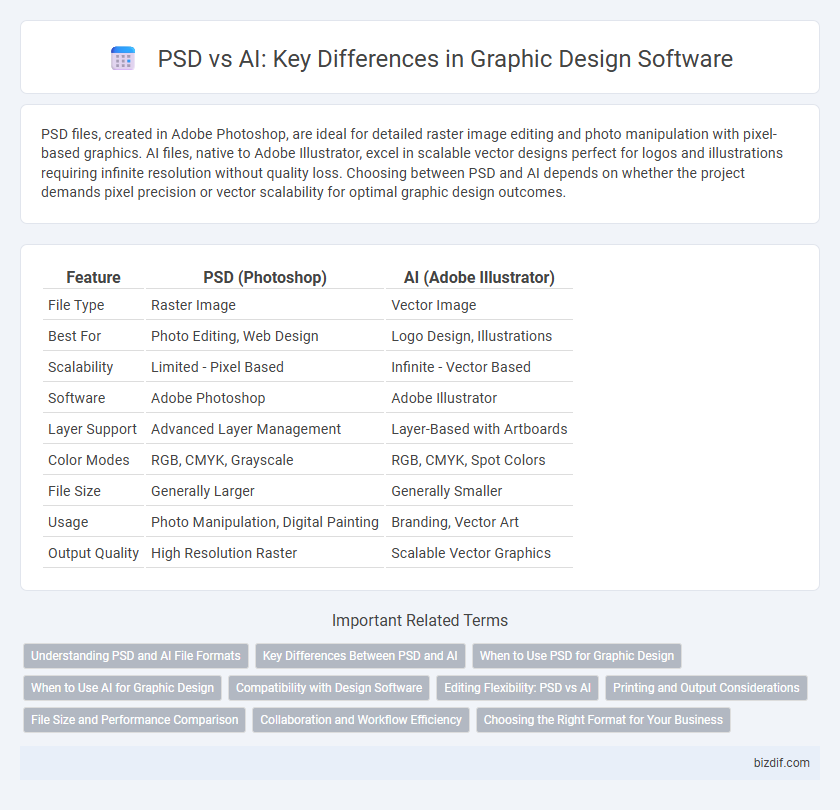PSD files, created in Adobe Photoshop, are ideal for detailed raster image editing and photo manipulation with pixel-based graphics. AI files, native to Adobe Illustrator, excel in scalable vector designs perfect for logos and illustrations requiring infinite resolution without quality loss. Choosing between PSD and AI depends on whether the project demands pixel precision or vector scalability for optimal graphic design outcomes.
Table of Comparison
| Feature | PSD (Photoshop) | AI (Adobe Illustrator) |
|---|---|---|
| File Type | Raster Image | Vector Image |
| Best For | Photo Editing, Web Design | Logo Design, Illustrations |
| Scalability | Limited - Pixel Based | Infinite - Vector Based |
| Software | Adobe Photoshop | Adobe Illustrator |
| Layer Support | Advanced Layer Management | Layer-Based with Artboards |
| Color Modes | RGB, CMYK, Grayscale | RGB, CMYK, Spot Colors |
| File Size | Generally Larger | Generally Smaller |
| Usage | Photo Manipulation, Digital Painting | Branding, Vector Art |
| Output Quality | High Resolution Raster | Scalable Vector Graphics |
Understanding PSD and AI File Formats
PSD files, created with Adobe Photoshop, are raster-based formats ideal for complex image editing with layers, masks, and effects, making them perfect for detailed photo manipulation and web graphics. AI files, developed by Adobe Illustrator, are vector-based formats designed for scalable graphics such as logos and illustrations, maintaining crisp quality at any size. Understanding the fundamental differences between PSD's pixel-driven structure and AI's mathematical paths is crucial for selecting the appropriate file format in graphic design projects.
Key Differences Between PSD and AI
PSD files, native to Adobe Photoshop, excel in pixel-based image editing, making them ideal for detailed photo manipulation and raster graphics. AI files, created with Adobe Illustrator, are vector-based, allowing for scalable graphics without loss of quality, perfect for logos and illustrations. The primary distinction lies in PSD's raster format suited for complex image compositions, whereas AI's vector format supports precision and infinite scalability.
When to Use PSD for Graphic Design
Use PSD files in graphic design projects that require complex image editing, high-resolution photo manipulation, and detailed layer work, as Adobe Photoshop excels in pixel-based artwork. PSD is ideal for web designs, digital painting, and retouching photographs where precise control over individual pixels and effects like masks, filters, and adjustments is necessary. When working on raster images intended for screen display or needing seamless integration with other Photoshop tools, PSD remains the preferred format.
When to Use AI for Graphic Design
AI files are ideal for creating scalable vector graphics, logos, and illustrations that require precise lines and shapes without loss of quality. Use Adobe Illustrator (AI) when designing materials that need to be resized frequently or adapted for various print and digital formats, such as branding assets and icons. AI supports advanced typography and extensive path editing, making it essential for complex vector-based graphic design projects.
Compatibility with Design Software
PSD files, native to Adobe Photoshop, offer extensive compatibility with raster-based software and are widely supported across various image editing tools. AI files, created in Adobe Illustrator, are optimized for vector graphics and seamlessly integrate with vector-based design applications, ensuring precision and scalability. Choosing between PSD and AI depends on the primary design software ecosystem and the specific needs for editing flexibility and output quality.
Editing Flexibility: PSD vs AI
PSD files, created with Adobe Photoshop, offer pixel-based editing, making them ideal for detailed photo manipulation and complex layering but can lose quality when scaled. AI files, developed in Adobe Illustrator, utilize vector graphics, enabling infinite scalability and precise adjustments without compromising resolution. For projects requiring extensive shape and line editing with scalable output, AI provides superior flexibility, while PSD excels in intricate raster image editing.
Printing and Output Considerations
PSD files excel in retaining complex photo-editing layers and effects, making them ideal for detailed image manipulation before printing. AI files are vector-based, ensuring crisp, scalable graphics without loss of quality, which is crucial for large-format printing and logos. Choosing AI over PSD guarantees sharper output and easier adjustments in print workflows, while PSD suits projects requiring intricate raster edits.
File Size and Performance Comparison
PSD files, native to Adobe Photoshop, often result in larger file sizes due to their support for multiple layers, high-resolution images, and extensive editing features. AI files, used by Adobe Illustrator, are typically more compact because they are vector-based, allowing for efficient scalability without pixel loss, which boosts performance during editing and exporting. While PSD excels in complex raster image manipulation, AI is optimized for faster performance with scalable graphics and smaller file sizes ideal for logos and illustrations.
Collaboration and Workflow Efficiency
PSD files, native to Adobe Photoshop, excel in collaborative projects requiring detailed photo editing and raster-based design, allowing multiple team members to work on complex layers and effects simultaneously. AI files, created in Adobe Illustrator, enhance workflow efficiency in vector-based design by enabling seamless scalability and precise control, which is essential for branding projects and print media. For teams focusing on collaboration, integrating both formats within a shared Creative Cloud environment streamlines asset management and accelerates project turnaround times.
Choosing the Right Format for Your Business
PSD files excel in detailed image editing and layered designs, making them ideal for businesses focusing on photo manipulation and complex visuals. AI files offer scalable vector graphics that maintain quality at any size, perfect for logo creation and branding materials requiring consistency across various formats. Selecting PSD or AI depends on your project needs: choose PSD for raster-based editing and AI for scalable, print-ready designs.
PSD vs AI Infographic

 bizdif.com
bizdif.com